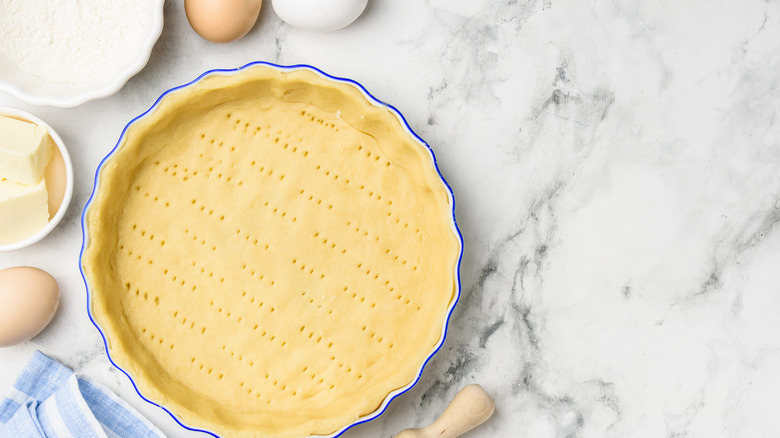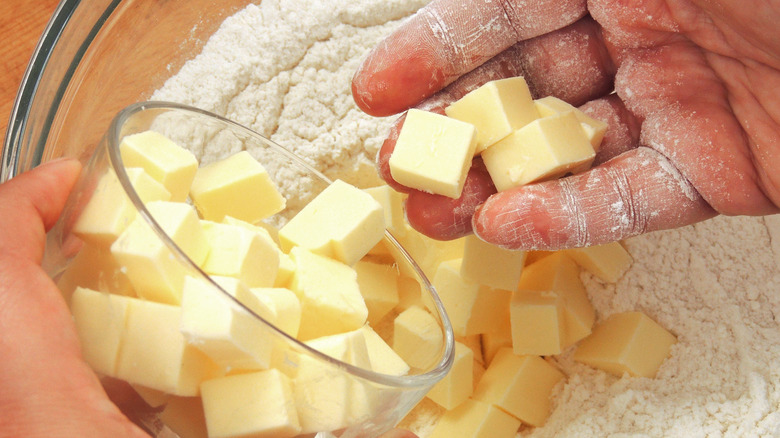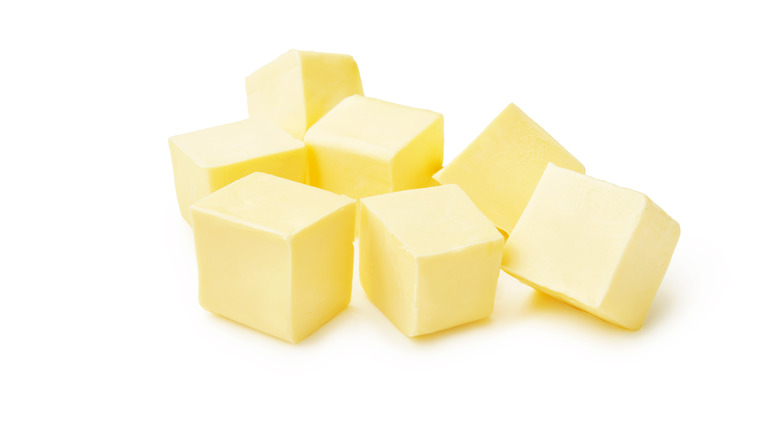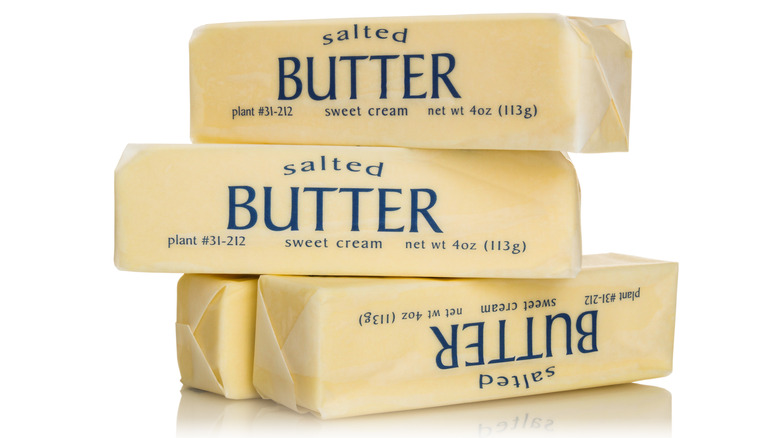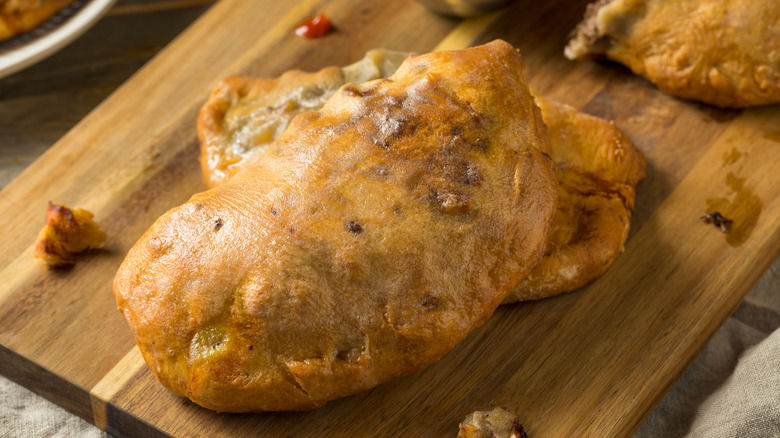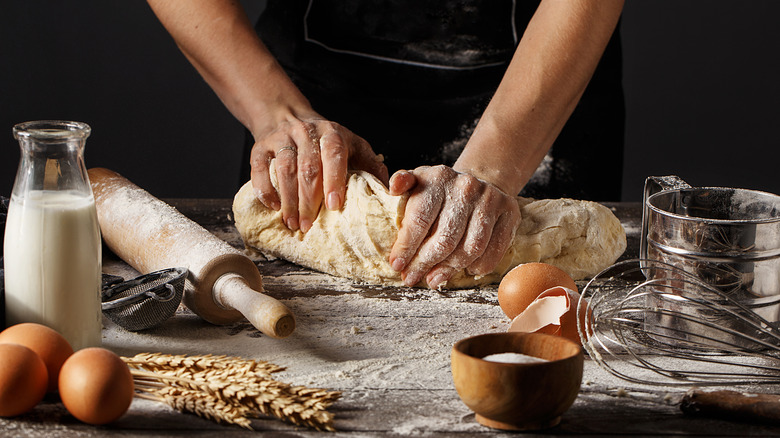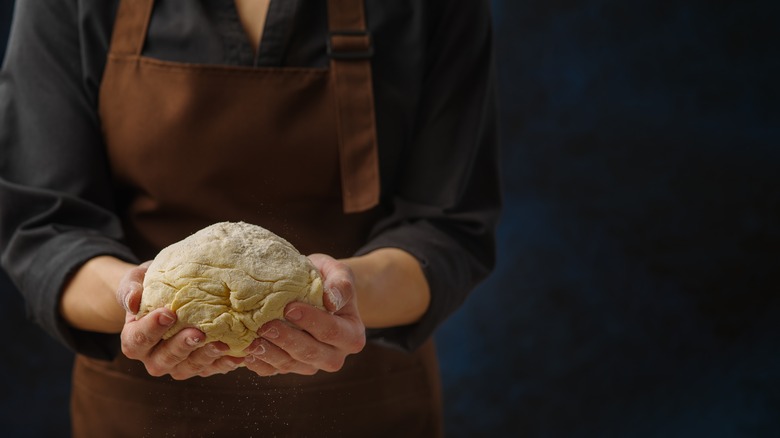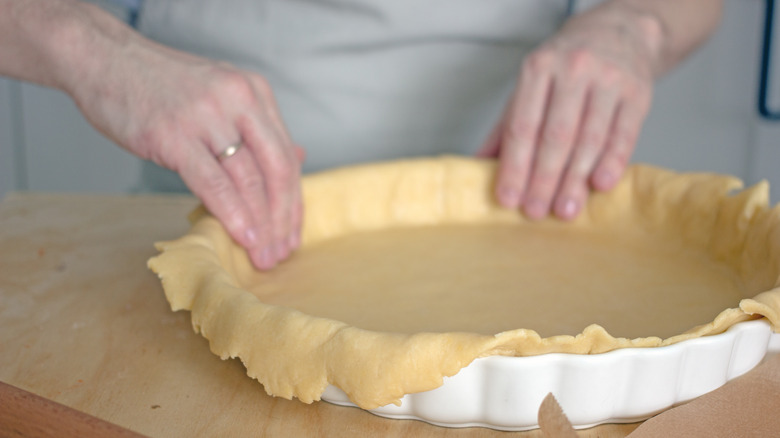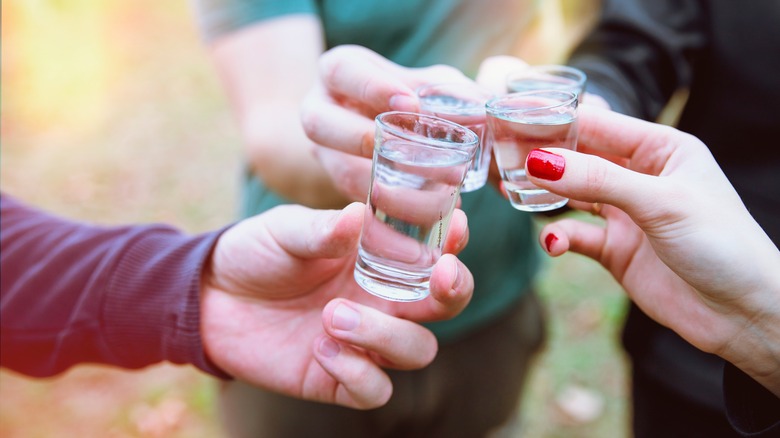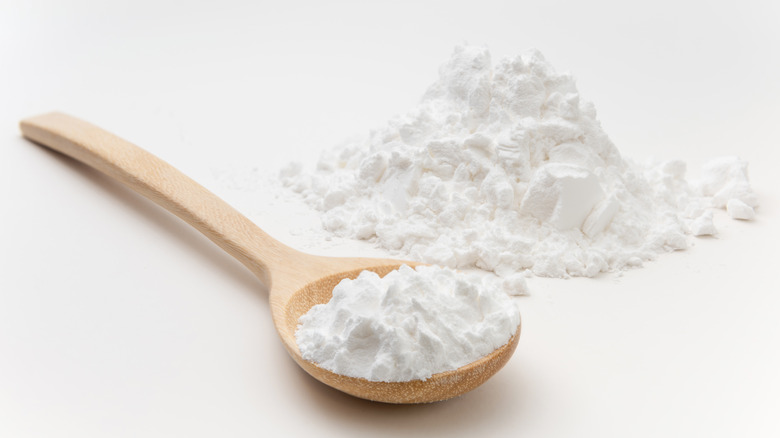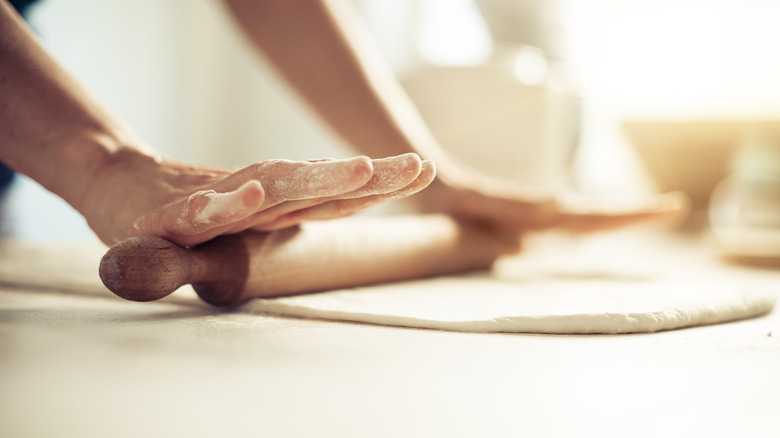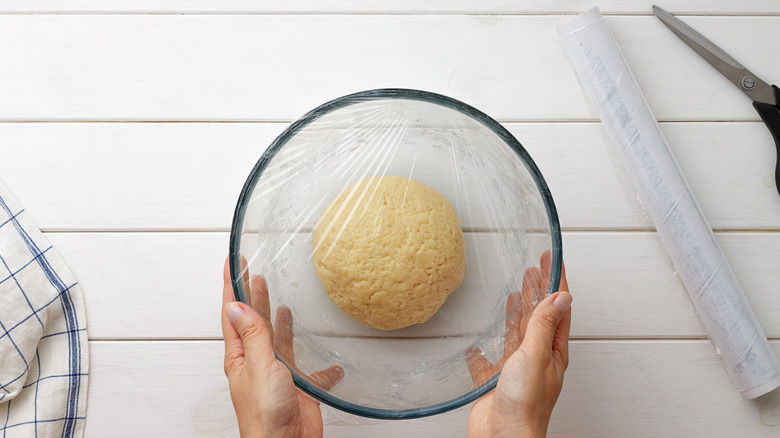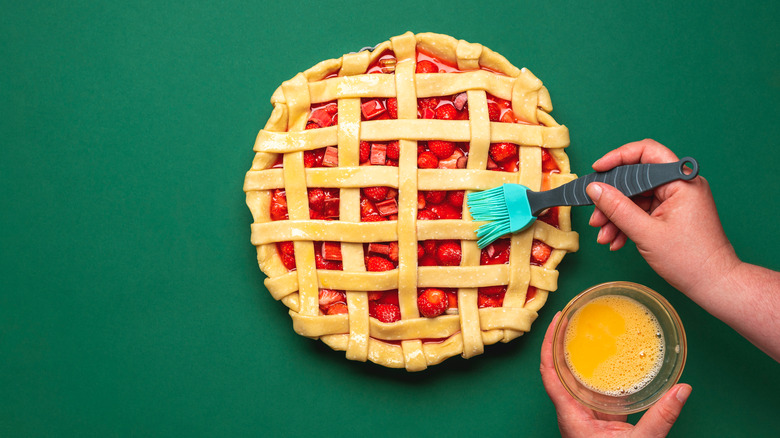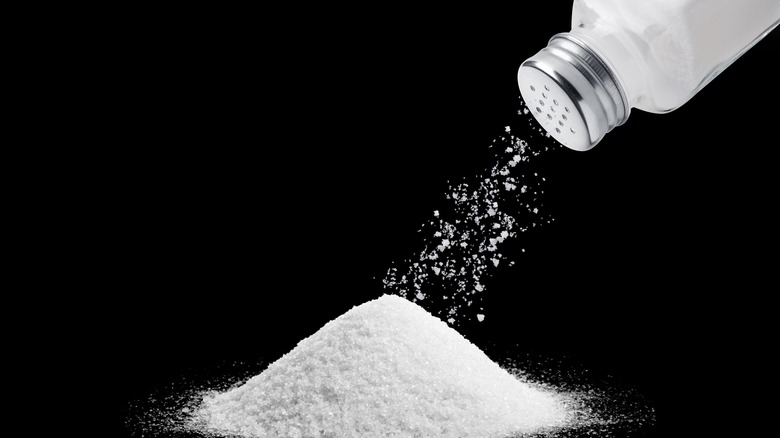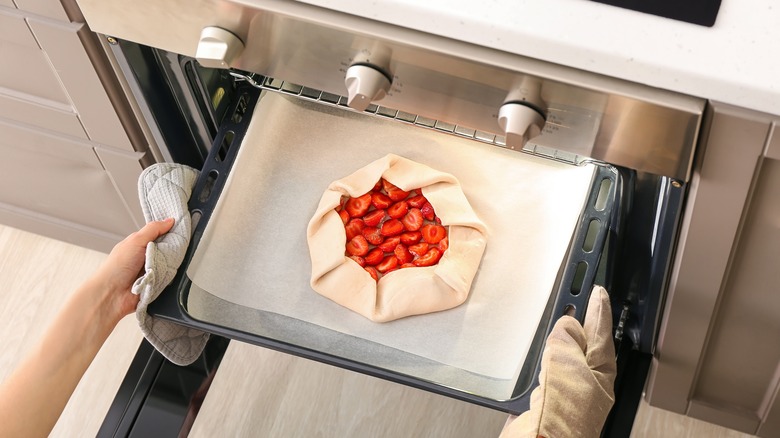15 Ways You're Ruining Your Pie Crust
Regardless of whether you love sweet apples, mixed berries, or even meat pie, you can always appreciate the flakiness and beautiful golden hue of a well-baked pie crust. There are several different types of pie crust that you may see used in recipes. The shortcrust dough is the most common pie crust used for baking fruit and cream pies. Small chunks of fat are added to a mixture of flour and salt to make a shortcrust. As it bakes, the butter melts and releases the moisture that creates the iconic crust of an apple or chocolate cream pie. Getting the perfect color and texture on your shortcrust is all about being careful and patient with your ingredients and methodology.
We've all had our fair share of disappointing pie crusts over the years. If you're looking to elevate your pie crust from average to exceptional, you'll want to check out our best tips and tricks.
Only using white flour
White, all-purpose flour is the standard when it comes to making pie crust. But one of the easiest ways to elevate the flavors and texture of your crust is to try to blend different flours into the crust. If you want a light, flaky pie crust, you should try to blend pastry flour with all-purpose flour. Since the pastry flour is low in gluten, the crust won't get as tough as if you used 100% all-purpose flour. Flour with higher gluten will result in a more pliable, bendy crust.
Other types of flour you may consider adding to your pie dough include whole wheat flour or spelt flour. Whole wheat flour has a distinctively nutty taste, while spelt flour has a somewhat sweet flavor profile and a decadently tender texture. If you are unfamiliar with how to bake with these types of flour, we recommend adding small ratios of flour until you get your desired flavor. We've found whole wheat and spelt flour taste especially wonderful in a blueberry crumb pie.
Using warm butter
The temperature of the butter you're working with is especially important in a pie crust. You want the butter to be cold enough that when it melts, it releases its water as steam, and causes those decadent flaky layers. If your butter is too warm, it will splatter out while the pie is baking and leaves a texture similar to that of wet cardboard.
According to Quartz, the best way to add butter to your pie crust is to place the amount of butter your recipe requires into the freezer for a few hours before you plan to make your pie crust. When you're ready to bake, you can cut the butter into a few large chunks and pop it directly into your food processor. If you are a stickler for the old-fashioned way of bringing pie crust together with your hands, you should instead grate the frozen butter using a box grater before mixing it with the rest of the ingredients (via People).
Opting for salted butter
There are so many different types of butter — how do you pick the best kind for baking? If you're baking, you should avoid using salted butter. This is because the amount of salt in a stick of butter varies depending on the brand. You can better control the saltiness of your pie crust by adding the salt separately from the dry ingredients. Instead, use unsalted butter for baking.
An even better option for baking pie crusts is to use European butter. In contrast to American butter, European butter has about 2% more butterfat. This produces a more vibrant yellow hue and creamier flavor. The slightly lower water content also means that the butter melts quicker as the pie crust bakes, which in turn imparts a stronger residual butter flavor on the crust. European butter is also a must-have item for laminating dough for pastries like croissants and danishes, but not for foods that require a lot of steam to produce a significant rise, such as the classic Southern biscuit (via Culinary Crafts).
Not trying a suet crust
Back before butter was conventionally available in stores, bakers used lard to impart the perfect flake on their pie crust. Some bakers still use a blend of lard and butter to make their pie crust. The tenderness and texture of the lard means that a baker is less likely to overwork the dough — which further results in a top-notch pie crust (via Southern Kitchen).
Another animal-based fat option for pie crust is suet — the same suet you put outside in a bird feeder. Suet is a dry, crumbly fat rendered from around the kidney area of ruminants like cows and sheep (via MasterClass). Because suet is highly saturated, it sticks together easily and does not get as oily as butter. It can be a more ideal addition than lard because it does not have as strong of a flavor and has a similar, high melting point. If you want the sweet undertone of butter in a sweet fruit pie, you should use a blend of suet and butter. For savory pies, chef Avery Wittcamp recommends sticking to a 100% suet crust.
Not using the fraisage method
According to the King Arthur Baking Company, the fraisage method involves cutting the butter into small chunks and adding liquid to the dough, like a standard pie crust you'd make with a food processor. But instead of letting the machine do all the work for you, you'll instead pile everything into a mound and use your hand to slowly press the butter into the dough into long, thin schmears. Work quickly, though, as moving slowly to mix your dough will cause it to melt out before you place the dough in the oven. Once your dough is mixed, you can chill it in the refrigerator for at least half an hour before baking.
The fraisage method is ideal for making pies because it ensures the butter and the flour are evenly distributed. The flour can wrap around the streaks of butter, which slowly allows the butter to melt in the oven as the pie bakes. This produces the layers needed for a flaky crust.
Overworking pie dough
You need to be careful with how much you work your pie crust if you want to ensure it has an immaculate texture. Overworking is a classic mistake with pie crusts because many bakers want to their pie crust to look seamless and evenly textured. The reality is that "shaggy" dough is okay — as long as it's not overworked. You should always stick to kneading your pie dough just enough so that the flour and the butter are combined, but not so much so that your dough becomes elastic and hard to work.
In hindsight, the easiest way to fix an overworked pie crust is to prevent overworking it in the first place. Other outlets, like Martha Stewart, have suggested that overworked pie crust can be brought back with the addition of an acid like vinegar or lemon juice. Acid supposedly reduces gluten development in the crust. Other bakers tout acid as the secret ingredient to make the dough easier to roll out, prevent shrinking, and diminish signs of oxidation.
Working in a space with a high ambient temperature
Heat is not good for a pie crust. If your dough is starting to get sticky, it is an indicator that your dough has been out of the refrigerator for too long. If you're making a pie crust on a notoriously warm day, you should try to return your dough to the refrigerator as quickly as possible to prevent all of the butter from running out of the dough and creating a sticky mess on your kitchen island, rolling pin, and everything in between.
Quartz notes that the best ambient temperature for making pie crust is between 68 and 72 degrees Fahrenheit. If you want to keep the temperature of your ingredients down, you can try to refrigerate your other ingredients and kitchen tools — such as the flour, measuring cups, and bowl — about 30 minutes before you start working with your dough.
Skipping the alcohol in the crust
Let's all take a shot — to a good pie crust. Alcohol, although an unexpected ingredient, is perfect to add to your pie crust if you want to keep it tender. Water alone stimulates gluten development in the dough. But since alcohol is made with a lower concentration of water and a higher concentration of alcohol, it will keep the dough hydrated and pliable without contributing to gluten development. The alcohol may also make the dough easier to roll out, which is another plus for bakers everywhere.
America's Test Kitchen recommends using an 80-proof vodka in pie dough, but you can also use other liquor with the same concentration of alcohol; their experiment with several different types of spirits did not produce a different flavor than the standard vodka. You should also not worry about the flavor of the alcohol shining through too much. The heat of the oven means that most of the alcohol gets burned off or mixed with other flavors.
Not keeping it moist with cornstarch
The secret to stopping sticky dough in its tracks can be found in your pantry. 177 Milkstreet recommends making a cornstarch gel by mixing a few tablespoons of cornstarch and water and microwaving it for about 30 seconds. The water in the gel doesn't perpetuate the development of gluten because it is bonded with cornstarch. After you have crafted your gelatinous concoction, you can add it to the food processor and pulse it with the dry ingredients before you add in your butter (or fat of choice).
Besides a softer, more tender crust, 177 Milkstreet also notes that this method can help reduce the shrinkage that many bakers experience when they're making their pie dough. Since the gluten is relaxed with the addition of the cornstarch gel, it won't sink into the pan when the pie hits the heat. A softer gluten structure also means that the pie dough is much easier to roll and shape.
Being too aggressive with rolling
Too much gluten development can be detrimental to a pie crust. And one of the unexpected ways you're causing gluten to develop in your pie crust is by taking your life frustrations out on the rolling pin and poor pie dough. The trick to rolling out pie dough evenly is to ensure that you are placing gentle, consistent pressure across the entire pin.
If you're rolling out your pie dough back and forth on only one spot, it will cause the gluten to develop in that singular portion of the crust. Southern Living instead recommends placing the pin in the center of the pie dough and rolling it away from you. Then, rotate your pie dough 90 degrees and repeat the process. This ensures that the entire pie dough is being rolled out equally. In addition, try to focus on pressing the dough with even pressure on each rotation. We recommend rolling your pie pastry until it is about ⅛ inch thick; too thick of a dough will result in a bready bottom while too thin of a dough will burn.
Forgetting to freeze your pie dough
You need to be on top of chilling your dough. Overall, we recommend doing a dual-chill period — after you mix the ingredients together and after you've rolled it out and shaped it into your pie tin. The Pioneer Woman, Ree Drummond, took this tip a step further and recommends freezing the pie dough for about 20 minutes before you're ready to shape your pie. This period is long enough for the gluten to slack and the butter to harden, but not cold enough to where your dough isn't malleable enough to roll and shape.
Drummond recommends placing the ball of dough into a large resealable bag and rolling it out with a rolling pin. Not only does this trick prevent you from getting your favorite rolling pin all gummy and gross, but it also makes the dough easy to pull out of the bag and drop straight into your pie tin.
Using the wrong wash for your crust
Washes can be a critical topping for your pie crust, both for color and flavor. Everyday Pie notes that wash can add an appetizing hue to your crust, help ingredients stick together, or act as an adhesive for a garnish like coarse sugar crystals.
The standard wash for a pie is an egg wash, made with a bit of water and egg. The King Arthur Baking Company notes that using a whole egg instead of just the whites in a wash will produce a more golden color; this is because the fat in the yolk helps to supplement the color. There are other types of wash you can use for your pie crust if you're looking to skip the traditional egg wash variety. If you're looking for a golden hue, Martha Stewart recommends instead making the wash with milk or cream. If you're making a vegan pie crust, you can use almond milk or coconut milk wash.
Not adding salt to your wash
Egg-washed crusts don't always have an outstanding flavor — even if adding the egg wash is critical to a perfectly appetizing color. We recommend adding a pinch of salt to the egg wash for a more remarkable flavor. The salt helps denature some of the proteins in the egg wash and helps thin it out a little bit. A thinner egg wash is easier to apply to your pie crust using a pastry or basting brush (via America's Test Kitchen). You won't need to add more than a pinch of salt to your egg wash before you slather it on your crust.
Salt can also be a helpful ingredient in the dough itself. Per What's Cooking America, salting the dough helps round out the sweetness of the other ingredients in the pie. The source also notes that a bit of salt can help reduce the feeling of oiliness on your palate when you eat fatty foods — or buttery pie crust.
Not using pie weights for blind baking
Blind baking is a critical pie step if you're trying to avoid the dreaded soggy bottom. You'll need to blind-bake, meaning to bake the crust without a filling, if you're making a no-bake pie or baking a custard pie that would otherwise curdle if it cooked at the temperature needed to brown the crust. If you're blind baking your pie crust, you need to use pie weights. These weights help keep the pie's shape in the tin. If you forget to use pie weights, the steam produced by the butter as it melts will cause the crust to either bubble up or slump in certain places.
While you can purchase ceramic pie weights, you can also use alternatives like rice, dried beans, or even pennies. With any type of pie weight, you'll first want to add a layer of parchment paper or foil before pouring in your weights (via Sally's Baking Addiction).
Skipping using a baking stone
A baking stone is a critical tool for pizza bakers, but did you know baking your pie crust on a baking stone can help improve its texture too? Since baking steels are made of a conductive heat source, the baking stone holds in the heat from the oven. This concentrated heat results in a more even browning on the crust and makes the texture of the crust hold up slightly better to a wet pie filling. Some sources have argued that using baking steel instead of a baking sheet can help combat oven hotspots and bake food more evenly without the need to continuously rotate during cooking (via HuffPost).
You'll need to let your baking steel preheat in the oven for at least an hour before you add in your pie, per HuffPost. You can also bring the heat up in the oven slightly higher than you need to bake the pie, then reduce the heat when it is time to put the pie in the oven. If you're using a baking steel to bake your pie, you should avoid using a glass or ceramic pie pan, since these materials can crack or warp with the intense heat of the stone. Stick to the cheap aluminum pie pans — they heat up faster in the oven anyway.
